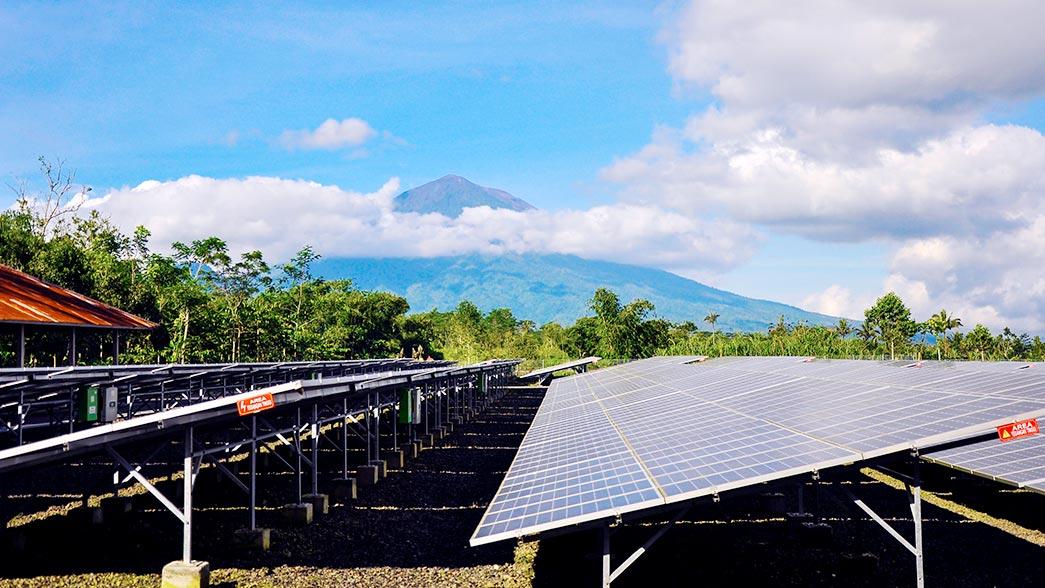Single title
INDONESIA’S CLIMATE FINANCE COMMITMENTS
The private sector will play an important role in Indonesia’s governmental development vision and strategy for reaching the emission target. State-owned enterprises (SOEs) and private sector companies are expected to invest more than 200 billion US dollars in infrastructure development. 200 billion US dollars of private investments are two-thirds of the total investment sum of around 300 billion US dollars needed by 2019. The Indonesian government will provide the missing last third (100 billion US dollars). Private sector emission reduction projects, the implementation of the RAN-GRK, and the National Action Plan for Climate Change Adaptation (RAN-API) are not financially supported by state funding. It is, however, unclear whether or not SOEs should be considered as private financing companies. The applied definition of private climate finance is not quite clear in this sense. This is a crucial point: SOEs are very important actors in the Indonesian economy due to them holding monopolies in electricity, oil and gas. Furthermore, most big banks (Mandiri, BNI and BRI) are state-owned.
PRIVATE SECTOR INVOLVEMENT
In preparation for the COP21 in Paris, there was an increase in awareness of climate-related topics among private companies in Indonesia. The number of private sector participants at the Indonesia Pavilion proved the rising interest. In Paris, these companies also promised an increase in their contributions to climate change activities/programmes. The APRIL Group, for example, announced its intention to double their peatland restoration commitment in Indonesia to 150,000 hectares, and that it will invest 100 million US dollars over the next decade in conservation and restoration. Furthermore, the Chamber of Commerce has become very active and interested in funding climate projects.
The Indonesian government welcomes this private sector involvement. The government introduced several initiatives related to climate finance development. One example is the launching of the first climate finance institution, Indonesia Climate Change Trust Fund (ICCTF), which was founded to increase capacity to manage climate financing. In 2010, the Norwegian government assured that it would give one billion US dollars for Indonesia’s “Reducing Emissions from Deforestation and Forest Degradation and the role of conservation, sustainable management of forests and enhancement of forest carbon stocks in developing countries” (REDD+) programme, and the Indonesian government has prepared financial mechanisms for the implementation of this performance-based scheme. There are also initiatives by the Ministry of Finance in budget tagging for government funds and an online reporting system (PEP Online for both mitigation and adaptation action plans) developed by Bappenas (Indonesian Ministry of National Development Planning).
The involvement of the private sector in climate-related activities is significantly influenced by banking institutions’ green lending or green investment programmes because Indonesia’s financial system is dominated by banking which accounts for 79.8 percent of the total assets compared to insurance (10.5 percent), finance companies (6.4 percent) and pension funds (2.6 percent). In 2014, the Financial Services Authority (OJK) developed the “Roadmap for Sustainable Finance”, which aims to increase the portfolio of green financing from financial institutions in Indonesia. Within the first phase after the issuing of the new regulations as the legal base for green financing (climate finance), OJK conducted a series of awareness raising programmes for the bankers. It is expected that bankers with the capacity to access the green projects will automatically reduce their risk perception towards this kind of project and that they are more likely to increase the volume of their financing of green projects. OJK encouraged banks support green finance projects, which motivated eight banks to volunteer as pilot banks in 2016. Volunteers are needed since most banks refuse to be green financing pioneers because they fear losing their competitiveness due to a lack of regulations.

THE IMPORTANCE OF RISK PERCEPTION
In general, it can be said that the banking sector is driven by risk perception and not by incentives, such as cheap financing for climate-related projects or increased financial resources for climate financing. Financial institutions in Indonesia usually do not see the lower cost of overseas money for climate projects as attractive enough to outweigh the burden of technical requirements, such as the “Measurable, Reportable, Verifiable” (MRV) mechanism. Banks face overall difficulty in finding good bankable offerings among climate-related projects. More criteria and requirements for climate projects would make them even less attractive to banks.
The increased interest in green projects during the last two years caused a high risk perception for projects that generate a lot of emissions or which are harmful to the environment. This high risk perception was mainly caused by stricter international financial policies (e. g. limited funding resources for coal-fired power plants) and stricter domestic government policies (e. g. in 2015 the government froze a company for causing a forest fire). This shift in policymaking led to higher potential risks of funding for the companies willing to invest in projects with negative climate impact. Banks see a greater danger in the provision of credits, especially to exporting companies which have a bad environmental reputation. Difficulties can arise if the government interferes with business practices because of questionable environmental behaviour. Problems with sales figures and customer relations could lead to weaker business performance and to non-performing loans. In this context, the Indonesian financial sector considers regional market cooperation such as ASEAN Economic Community (AEC) as a challenge because it requires reforms and includes international standardised processes (for example in climate related issues). As a result, banks in Indonesia are now more eager to learn about green and climate finance.
Another possible source for climate finance is the Syariah Bank. Islamic financing has criteria which are close to those of green financing or climate protection financing. Indonesia, as the biggest Muslim country in the world, has huge potential for the generation of financing for climate-related projects. Many banks already have syariah branches, but this system still needs further improvement to achieve the aspired goal.
CARBON PRICING CONSIDERATIONS
In 2009, the Indonesian government considered a carbon tax to increase investment in climate protection projects. However, it was assumed that a carbon tax would be a negative signal for investors. Therefore, tax incentives for imported green machinery are currently favoured by the government. An Indonesian carbon market is still not feasible in the short run because the current range of information is not sufficient for such a scheme. Furthermore, a functioning competitive carbon market would be difficult to implement, because of monopolies by certain SOEs (such as PT Pertamina for oil and gas, and PT PLN for electricity).
As a result, Indonesia is trying to implement a carbon market scheme on the basis of Joint Crediting Mechanisms (JCM) and by using some pilot projects for a voluntary carbon market. It is expected that Indonesia will gain more technical knowledge from these pilot projects which would enable the government to introduce a national carbon market.
CONCLUSION
Indonesia needs to strengthen its capacity to improve private sector involvement and contributions to finance climate-related projects. To achieve this goal, climate finance actors must be provided with public financing mechanisms in order to improve the data and information situation. Furthermore, there must be improvement in stakeholder coordination for climate finance. It is of urgent importance that the Indonesian government and OJK increase the implementation of more climate-related projects by introducing regulations and by giving banks green-project-related investment incentives. Green business opportunities should be supported by adequate lending models, incentives for development, and simple, standardised procedures.
The G20 conferences generate attention, and they usually increase awareness of the discussed topics among member states. If G20 members increase the volume of their climate-related financing, the Indonesian government will very likely adjust its policies.
ABOUT THE AUTHOR
Syamsidar Thamrin is Deputy Director Weather and Climate at the Indonesian Ministry of National Development Planning.
The author would like to thank Raymond Bona and Marsha Ranti for their input and comments on an earlier version of this paper.



